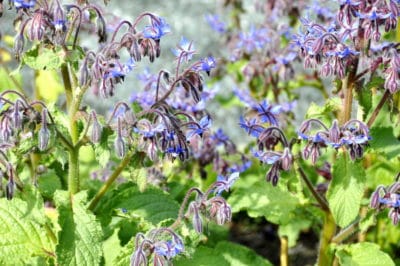The Plant
A less common but largely beneficial garden herb, borage is renown for its gorgeous flowers. They are star-shaped and dangle in firework-like clusters. Flowers start out as fuchsia bells and then fade to blue as they mature. It is an annual but readily reseeds itself each year though it isn’t aggressive enough to be considered invasive.
In The Garden
Planting pollinator attractants nearby fruit trees and bushes will ensure better pollination. Placing borage next to plants that are difficult to pollinate will raise fruit yields. Here is a list of great borage companions for the garden.
- Squash
- Strawberries
- Tomatoes
- Legumes
- Brassicas
A place in full sun will produce the most amount of flowers, however, borage does well in partial shade also. The flowers will bloom from late spring through the summer. Stagger your plantings to ensure a steady supply of edible flowers.
Pick them as you eat them because the greens and flowers don’t last too long after harvest. If you are seeking storage, consider drying them for later use in soups, sauces, or as a tea.
In The Kitchen
With legends as old as ancient Greece, this little flower has been on plates and in tonics for centuries. The leaves are hardy salad greens. The flowers are a prized herb, garnish, and an ingredient known for their mild cucumber-like flavor. They top salads, soups, desserts, and cocktails. They’re pressed into jellies and preserves and used as a vegetable.
The young leaves and flowers are best; when the plant gets too mature it becomes covered with prickly hairs. There is controversy over the potential risks of eating borage and it is advised that it should not be eaten during pregnancy. This is due to the presence of some toxin alkaloids, which can have a stressful effect on the liver.
Medicinal
Borage plants contain high amounts of an Omega 6 fatty acid called GLA. For this reason, borage is used commercially to produce a variety of GLA supplements. These omega concentrations help with everything from arthritis to headaches and stomach issues.
Throughout the ancient Mediterranean, borage was a common remedy for depression. It is used by herbalists as a diuretic (increases urination) and a sudorific (increases sweat). A tea made from the whole dried plant is commonly applied to eczema, acne, gingivitis and various skin conditions.
